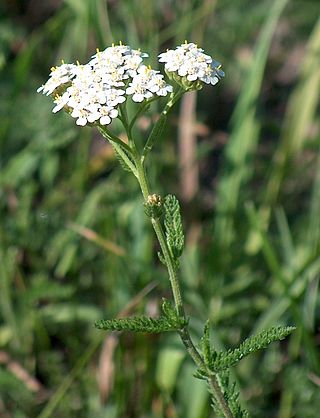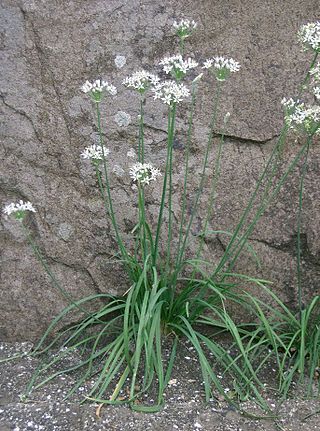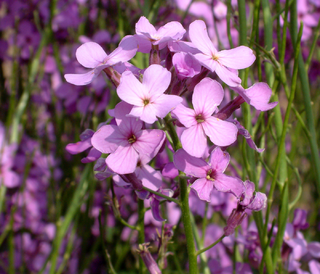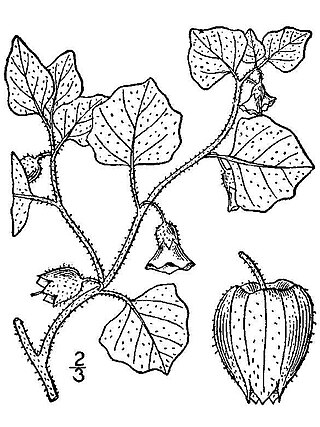
Achillea millefolium, commonly known as yarrow or common yarrow, is a flowering plant in the family Asteraceae. Growing to 1 metre tall, it is characterized by small whitish flowers, a tall stem of fernlike leaves, and a pungent odor.

Achillea is a genus of flowering plants in the family Asteraceae, known colloquially as yarrows. The plants typically have frilly leaves. The common name "yarrow" usually refers to A. millefolium. The genus was named after the Greek mythological character Achilles, whose soldiers were said to have used yarrow to treat their wounds; this is reflected by common names such as allheal and bloodwort. The genus is native primarily to Eurasia and North America.

Matricaria discoidea, commonly known as pineappleweed, wild chamomile, disc mayweed, and rayless mayweed, is an annual plant native to North America and introduced to Eurasia where it grows as a common herb of fields, gardens, and roadsides. It is in the daisy family Asteraceae. The flowers exude a chamomile/pineapple aroma when crushed. They are edible and have been used in salads and to make herbal tea.

Allium tuberosum is a species of plant native to the Chinese province of Shanxi, and cultivated and naturalized elsewhere in Asia and around the world.

Hesperis matronalis is an herbaceous flowering plant species in the family Brassicaceae. It has numerous common names, including dame's rocket, damask-violet, dame's-violet, dames-wort, dame's gilliflower, night-scented gilliflower, queen's gilliflower, rogue's gilliflower, summer lilac, sweet rocket, mother-of-the-evening, Good & Plenties, and winter gilliflower.

Persicaria maculosa is an annual plant in the buckwheat family, Polygonaceae. Common names include lady's thumb, spotted lady's thumb, Jesusplant, and redshank. It is widespread across Eurasia from Iceland south to Portugal and east to Japan. It is also present as an introduced and invasive species in North America, where it was first noted in the Great Lakes region in 1843 and has now spread through most of the continent.

Myrrhis odorata, with common names cicely, sweet cicely, myrrh, garden myrrh, and sweet chervil, is a herbaceous perennial plant belonging to the celery family Apiaceae. It is the only species in the genus Myrrhis.

Lilium candidum, the Madonna lily or white lily, is a plant in the true lily family. It is native to the Balkans and Middle East, and naturalized in other parts of Europe, including France, Italy, and Ukraine, and in North Africa, the Canary Islands, Mexico, and other regions. It has been cultivated since antiquity, for at least 3,000 years, and has great symbolic value since then for many cultures. It is susceptible to several virus diseases common to lilies, and especially to Botrytis fungus. One technique to avoid problems with viruses is to grow plants from seed instead of bulblets.

Lycopodium clavatum is the most widespread species in the genus Lycopodium in the clubmoss family.

Ageratum houstonianum, commonly known as flossflower, bluemink, blueweed, pussy foot or Mexican paintbrush, is a cool-season annual plant often grown as bedding in gardens.

Hemerocallis fulva, the orange day-lily, tawny daylily, corn lily, tiger daylily, fulvous daylily, ditch lily or Fourth of July lily, is a species of daylily native to Asia. It is very widely grown as an ornamental plant in temperate climates for its showy flowers and ease of cultivation. It is not a true lily in the genus Lilium, but gets its common name from the superficial similarity of its flowers to Lilium and from the fact that each flower lasts only one day.

Symphyotrichum laeve is a flowering plant native to Canada, the United States, and Coahuila (Mexico). It has the common names of smooth blue aster, smooth aster, smooth-leaved aster, glaucous Michaelmas-daisy and glaucous aster.

Verbena bonariensis, the purpletop vervain, clustertop vervain, Argentinian vervain, tall verbena or pretty verbena, is a member of the verbena family cultivated as a flowering annual or herbaceous perennial plant. In USA horticulture, it is also known by the ambiguous names purpletop and South American vervain. For the misapplication "Brazilian verbena" see below.

Corylus americana, the American hazelnut or American hazel, is a species of deciduous shrub in the genus Corylus, native to the eastern and central United States and extreme southern parts of eastern and central Canada.

Lathyrus hirsutus is a species of wild pea known by several common names, including Caley pea, singletary pea, hairy vetchling, and Austrian winter pea. It is native to Europe, North Africa, and much of Asia, and it is known from other continents, including North America, as an introduced species. This is an annual herb producing a winged stem and leaves each made up of two leaflike leaflets with a branching, coiled tendril. The inflorescence holds one or two pink, blue, or bicolored pea flowers each 1 to 1.5 centimeters wide. The fruit is a dehiscent legume pod covered in hairs with each hair growing from a minute bulbous base. The rest of the plant is generally hairless.

Erodium cygnorum is a species of herb native to Australia.

Achillea ageratifolia, the Balkan yarrow or Greek yarrow, is a species of flowering plant in the daisy family Asteraceae, native to Bulgaria and Greece. Growing to 20 cm (7.9 in) tall and broad, it is a compact herbaceous perennial. It is a highly variable species, with three recognized subspecies. They have erect, simple, somewhat woody based stems. The narrow grey-green foliage resembles that of a related genus Ageratum, hence the Latin specific epithet ageratifolia. The solitary, daisy-like composite flower heads are white with yellow centres and about 2–3 cm across. They appear May–July in the northern hemisphere.

Physalis pubescens is a species of flowering plant in the nightshade family known by many common names, including husk tomato, low ground-cherry and hairy groundcherry in English, and muyaca and capulí in Spanish. It is native from Brazil, but also found in southern half of the United States, Mexico, Central and much of South America. It can be found elsewhere as an introduced species and sometimes a weed. It can grow in many types of habitat, including disturbed areas. This is an annual herb producing a glandular, densely hairy stem up to about 60 cm (24 in) in maximum height from a taproot. The oval or heart-shaped leaves are 3–9 cm (1.2–3.5 in) long and have smooth or toothed edges. The flowers blooming from the leaf axils are bell-shaped and about a centimeter long. They are yellow with five dark spots in the throats, and have five stamens tipped with blue anthers. The five-lobed calyx of sepals at the base of the flower enlarges as the fruit develops, becoming an inflated, ribbed, lanternlike structure 2–4 cm (0.79–1.57 in) long which contains the berry.

Hymenocallis occidentalis is a plant species native to the southern United States. It is known along the Gulf Coast from South Carolina to Texas, and in the Mississippi Valley as far north as southern Illinois and Indiana. It is also cultivated as an ornamental elsewhere because of its showy, sweet-smelling flowers. Common names include woodland spider-lily, hammock spider-lily or northern spider-lily.

Clinopodium menthifolium, commonly known as the wood calamint or woodland calamint, is a species of flowering plant in the mint family, Lamiaceae. It is found throughout southern and central Europe from the United Kingdom and east as far as temperate parts of Asia, and as south as North Africa. It grows up to 1,700 m (5,600 ft) in elevation.




















